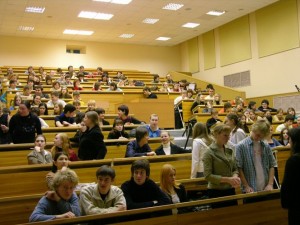ULYANOVSK, Russia | While Moscow leads the way in almost every field of activity – politics, economics, cultural affairs and education – the regions seem to trail behind. But maybe not for much longer.
According to a stereotype familiar to every graduating high school student, the facilities and study programs of regional universities are far behind those of their Moscow counterparts. More importantly, many believe it will be easier in the long run to find a better job with a degree from a Moscow university.
Every June, graduates from the outlying districts flow into Moscow in search of spots in the capital’s universities. As a result, the regions suffer not only from the immediate “brain drain” of young minds, but also from long-term consequences since many do not return after completing their degrees.
“I would simply rot in my hometown,” admitted Maxim Pavlov, a first-year student who left Ulyanovsk to study at the Moscow Institute of Physics and Technology. “I couldn’t find a department that interested me [in Ulyanovsk]. Here, I have prospects and I’m in a great environment.”
Russian education officials hope to reverse this trend in the near future. In order to strengthen higher education in the regions, the government recently established “federal universities” – large-scale facilities resulting from the mergers of several smaller institutes. The federal universities are to receive targeted funds that will allow them to recruit more qualified staff and improve their technical capacities, making them more attractive to regional students.
Two pilot federal universities, the Southern Federal University and the Siberian Federal University (SibFU) were created in November 2006 under the banner of the Priority National Project “Education”. The law officially establishing the federal universities was passed at the end of January 2009.
Despite the increased government support, federal universities have been established as autonomous institutions, according to the Ministry of Education and Science. Rectors are to be appointed for a period of five years on the basis of a decision by their respective cabinet councils. The universities have the right to set their own study programs, according to their own educational standards.
The main strategy of federal universities is strength in numbers. SibFU is now home to 43,000 students. The university integrated four Siberian higher education institutions: Krasnoyarsk State University, Krasnoyarsk State Academy of Architecture and Civil Construction, Krasnoyarsk State Technical University, and the State University of Non-Ferrous Metals and Gold.
These integrated education complexes are expected to become centers of advanced training creating skilled personnel for a range of industries and public services in Russia. Another aim of the federal universities is to involve students in the research process, combining practical application and theory, based on international standards.
Federal universities are striving for the three “Is”: integration, innovation, and internationalization. All of these taken together will make them more competitive against Moscow institutions, say their supporters.
Federal universities also have the loftier goal of competing on the world stage. In 2008, only two Russian universities ranked on Shanghai Jiao Tong University’s prestigious list of the top 500 world universities: Lomonosov Moscow State University (70th place) and St. Petersburg State University (between 303rd and 401th place). The federal universities are expected to participate in international educational and scientific programs and compete for spots among the top 500 schools.
Many students welcome the federal universities and the introduction of higher education standards in the regions.
“It’s not necessary to drag yourself to Moscow, I believe,” said Vicktoria Gurskaya, a graduating student at Ulyanovsk State University. “The main factors for a decent education are proper incentives and the desire of the student [to do well]. Good teachers and professors don’t necessarily live in Moscow.”
University instructors also believe the federal universities might have far-reaching significance. “SibFU academic and research staff have opportunities to participate in various international programs, and to work on their own projects which are financed pretty well,” explained Irina Nikolaevna Semyachkina, an instructor at the Krasnoyarsk State Pedagogical University.
Indeed, SibFU received an initial investment of 17 billion rubles (over $650 million USD) in state funds and support from local government and businesses. The government plans to spend around 150 billion rubles on the creation of federal universities until 2020, according to the Ministry of Education and Science.
At least two more federal universities are planned: one in the far east of the country, and another in the Urals region.

